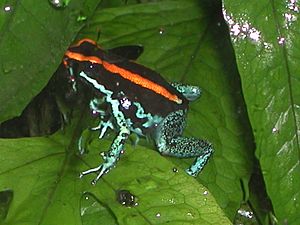Golfodulcean poison frog facts for kids
Quick facts for kids Golfodulcean poison frog |
|
|---|---|
 |
|
| Conservation status | |
| Scientific classification | |
| Synonyms | |
|
Dendrobates tinctorius vittatus Cope, 1893 |
The Golfodulcean poison frog (Phyllobates vittatus) is a type of frog. It belongs to the Dendrobatidae family, also known as poison dart frogs. This frog is found only in Costa Rica.
Contents
What Makes Them Poisonous?
Like other frogs in the Phyllobates group, Golfodulcean poison frogs have strong poisons in their skin. These poisons are called neurotoxins, which affect the nervous system. Even though it's not the most poisonous frog in its group, it's still very toxic.
If a large amount of this poison gets into a body, it can cause severe pain. It can also lead to seizures and even paralysis. The frog shows off its bright, colorful body to warn predators that it is poisonous.
These frogs are quite large for a poison dart frog. This means they can store a lot of poison in their skin. Interestingly, frogs kept in zoos or as pets do not have this poison. This suggests they don't make the poison themselves. Instead, they likely get it from certain insects or other small creatures they eat in the wild.
Scientists are still trying to figure out the exact source of the poison for Phyllobates frogs. However, some poisonous birds in New Guinea get their poison from a small beetle called a Melyridae beetle.
What Do They Look Like?
The Golfodulcean poison frog is a fairly large poison frog. It can grow to about 3.5 centimeters long when it's an adult. Female frogs are usually bigger than males.
These frogs have smoother bodies compared to other frogs in their group. Their backs are almost perfectly sloped. Unlike some related frogs, you usually can't see their shoulder blades under their skin. This makes them look a bit plump.
The frog's main color is black. But it can look shiny because of special chemicals in its skin. Its legs often have a mix of blue colors. The sides of its body might show a marble-like pattern of blue or green.
One of the easiest ways to spot a Golfodulcean poison frog is by the two stripes on its back. These stripes are why it got its name. They are usually bright orange, but they can also be golden, yellow, or green. These stripes run all the way from just above the frog's rear end to the tip of its nose.
Where Do They Live?
These frogs naturally live in moist and wet lowland forests. You can find them at elevations from about 20 to 550 meters above sea level.
They are diurnal, which means they are active during the day. They are also terrestrial, meaning they live on land. They are often found near streams in the forest.
Female frogs usually lay their eggs on leaves above the ground. Once the eggs hatch, the male frogs carry the tiny tadpoles on their backs. They take them to forest streams where the tadpoles finish growing into frogs.
Keeping Them as Pets
Golfodulcean poison frogs are social animals. This means they like to live in groups. Recently, they have become available for people to keep as pets.
If you want to keep these frogs, they need a special home called a vivarium. A good size for a vivarium is about 100x60x60 centimeters. This gives the frogs enough space to move around on the ground and to climb.
You should put a clean, mossy layer on the bottom of the vivarium. You can also add a carpet of leaves. But be very careful to make sure the leaves are perfectly clean. Many types of harmful fungi can be deadly to amphibians like frogs.
Phyllobates frogs can climb by sticking to leaves with special pads on their toes. This is similar to how geckos climb. So, any climbing surfaces in their home should be smooth and vertical. These frogs are very good at climbing. Because of this, their vivarium must be completely sealed so they cannot escape.
See also



